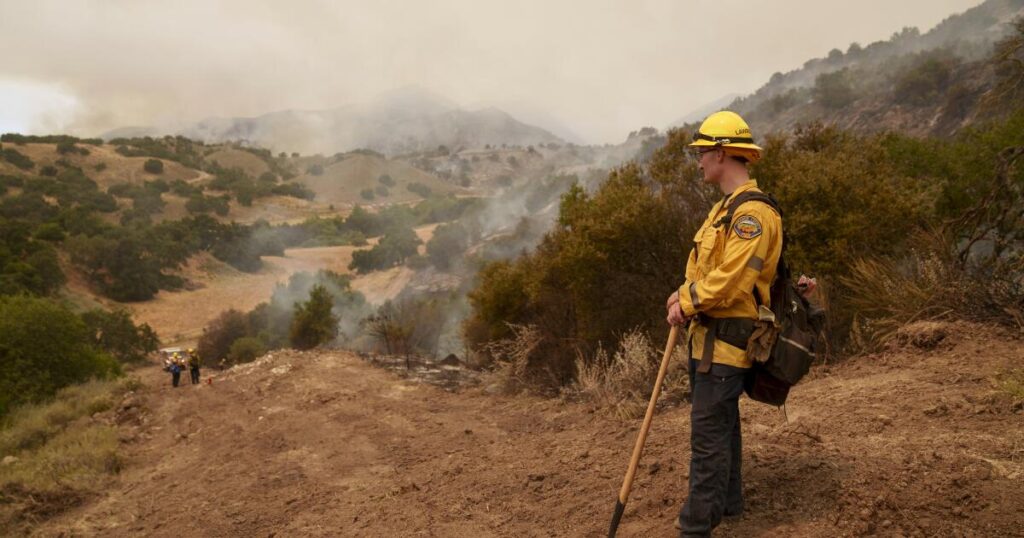A wildfire broke out near Oroville during California’s record-breaking heat wave last week, destroying 13 homes and a dozen other structures, state fire officials said.
The Thompson Fire coincided with a heat wave that moved over the West on Friday, setting the stage for the fire to sustain itself on brush and vegetation amid extreme heat and dry winds in Butte County. Over the weekend, the area expanded to 3,789 acres, and on Monday the California Department of Forestry and Fire Protection declared it 100% contained.
“The word our fire chief used to describe this fire is ‘stubborn,'” Cal Fire spokesman Rick Carhart said. “The day the fire broke out was extremely hot, very windy, and the humidity was almost is zero.”
Northerly winds of 20 mph fanned the fire, which burned in steep terrain and put pressure on firefighters.
Thirteen single-family homes were destroyed, five homes were damaged and 13 other structures were destroyed, according to Cal Fire. Two firefighters were injured, Carhart said. There were no reports of civilian injuries.
Although the Thompson Fire is under control, the lingering heat wave sets the stage for drier conditions and extreme temperatures that could spark more fast-moving wildfires and stretch firefighting resources. Temperatures continued to be 10 to 15 degrees above average across large swathes of the state on Tuesday, with no signs of abating into the weekend.
“Sustained high temperatures are really going to have a big impact, stressing vegetation and especially firefighters,” said Alex Tardy, a meteorologist with the National Weather Service in San Diego.
Among other fires in the state, the Vista Fire is burning in the San Bernardino National Forest near Mount Baldy and Wrightwood, the U.S. Forest Service said.
The fire nearly doubled in size overnight and has burned 1,295 acres since it started Sunday afternoon in steep, remote terrain. Details of the fire’s containment were not immediately known.
After a season of heavy rains, the area has dense vegetation and a hot climate.
“The area around Wright Creek is the wettest part of the mountain and has a lot of vegetation,” Tardy said. “That means a lot of fuel is already in place.”
The heat wave was unprecedented in severity and duration, setting multiple heat records in the Golden State and across the western United States, according to meteorologists.
Lancaster and Palmdale continued to set records for consecutive days with 110 degrees or above, reaching five days on Monday, according to the National Weather Service. The previous record for both cities in the Antelope Valley was three days.
Las Vegas is expected to break its record streak of five consecutive days with temperatures at 110 degrees or above, reaching that level for five consecutive days on Monday. The current record has stood for 10 consecutive days, but forecasts show temperatures will remain so high next week that they could easily break the previous record.
Several other areas, including Madera and Needles, also hit single-day record highs on Monday, according to the National Weather Service. The temperature in Palmdale reached 112 degrees on Monday, the fourth day in a row above normal temperatures.
Madera hit 110 degrees, 3 degrees above the record; Merced hit 109 degrees, slightly higher than the highest single-day temperature record dating back to 1921; Las Vegas hit 115 degrees, higher than the 2021 record The record set on July 8, 2017 was 1 degree higher; the temperature at Needles in the Mojave Desert reached 123 degrees, 3 degrees higher than the record set on July 8, 2017.
In Santa Barbara County, authorities issued evacuation orders Monday after a wildfire forced residents near Figueroa Mountain from their homes.
The Lake Fire is still burning on the western edge of the Los Padres National Forest due to record-low humidity, according to the U.S. Forest Service. The fire, first reported Friday afternoon northeast of the city of Los Olivos, has burned 26,176 acres, making it California’s largest fire so far this year, officials said.
The fire burned near Lake Zacca and several residential properties, including Sycamore Valley Ranch (formerly Michael Jackson’s Neverland Ranch). Firefighters reported that the fire was 16% contained as of Tuesday evening.
Officials announced Monday that evacuations have begun for portions of Figueroa Mountain, south of the Sisquak River Tunnel House, east of Figueroa Creek, north of the southern end of Cachuma Mountain and west of the Los Padres National Forest area. While much of the fire grew overnight, on Tuesday it pushed evacuation warnings to the edge of the communities of Los Olivos and Santa Ynez and triggered expanded evacuations to the U.S. Forest Service north of Figueroa Creek and east of Figueroa Creek Goat Rock’s Order.
The National Weather Service issued a red flag warning for the area Tuesday afternoon due to high winds and intense heat.
“It’s hot, dry and windy today,” said Dan Michael, a fire behavior analysis intern with the interagency incident management team responding to the fire.
Even at night, when fire activity typically wanes, the Lake Fire remains active because it burns on ridge tops, where temperatures can be 30 degrees or more warmer than at lower elevations, Michael said.
“The marine layer comes in and it can’t get to where the fire is burning,” Michael said. “It’s much worse at night.”
Los Angeles Times special correspondentKerry Bleckinger Grace Toohey contributed to this story.

